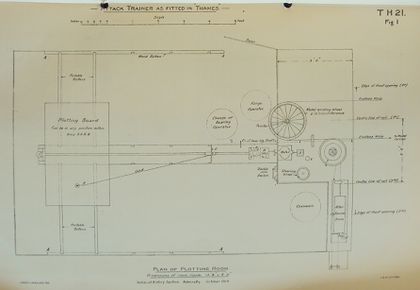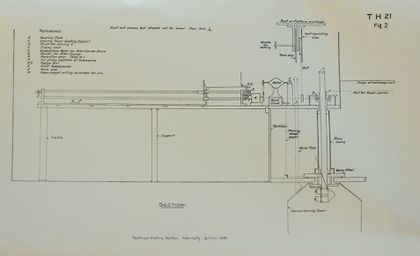Attack Teacher
The Attack Teacher was a training device created by the Royal Navy in 1913 for the purpose of allowing submarine commanders to practice stalking a target and achieving a successful firing position. It was regarded as an analogue to gunnery training aids, such as the Dotter, in that it would permit economical and repetitive training for operations that are resource-intensive and, in this case, quite dangerous to practice in a literal manner.
History
The Gibraltar Submarine Flotilla created a primitive Attack Teacher in 1913, and an improved version was being built at Dundee when the Great War broke out. The demand for training submarine commanders for action was growing so quickly that a refined design was produced in spring of 1915 for use in Thames at Sheerness. This design was soon adopted for use at all submarine depots.
Basic Design
The device was a plotting table upon which multiple model ships (scale 10 inches being one mile) could be moved about by an electric motor. Underneath the table was a "conning tower" in which the man being trained would sit, able to surveill the models through an actual periscope and with a voice-pipe at hand to command helm and speed orders for his "submarine". Men called the "coxswain" and "bearing operator" worked handles to turn the bearing ring on the periscope or the angle to the ships to mimic what would be seen in a real, evolving submarine attack.
A clockwork "alter course drum" was etched with data indicating various rates of turn for different rudder angles as obtained through experimental trials with the submarine being simulated. Each time the submarine commander orders a turn, the drum would be started and the "coxswain" would work his controls to trace the proper curve on the drum.
The courses of submarine and target were drawn on a plot. Orders to lower or raise the periscope were manually noted on the plot so that stealthiness could be adjudicated, and the prism covered or uncovered to simulate the perceptual effect.
Gauze of various thickness could be placed over the periscope to mimic different visibility conditions. Target zig-zagging could be mimicked by "lifting the pin representing the submarine and swining it and the plot of the track of the submarine round the pointer representing the position of the enemy, through an angle equal to the alteration of course. At the same time, the target model is rotated on its angle through the same angle."
When the attacking officer elected to fire his torpedo, he would announce the deflection he was allowing, and this would be compared to the correct one for the track angle and target speed being used, allowing the result to be judged.
See Also
Footnotes
Bibliography
- Admiralty, Technical History Section (1921). The Technical History and Index: Submarine Administration, Training and Construction. Vol. 3, Part 21. C.B. 1515 (21) now O.U. 6171/13. At The National Archives, Kew, United Kingdom.

